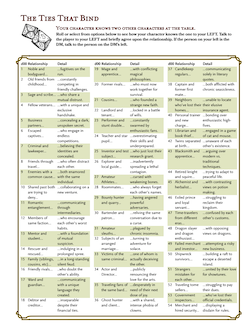The Ties That Bind...
I've been GMing at my local area game store lately, running Adventurer's League (AL) 5e games. If you've not done that before, you can think of it like a "pick up game" of D&D: essentially randomized players and GMs from week to week, with adventure content that may or may not have serial thru-lines. It's good fun, especially if you're not hung up on "The Story", and have the good fortune to have a bevy of experienced players in your local area.
One of the challenges inherent in this kind of organized play is that, by design, none of the characters necessarily know each other at the table. This causes an immediate role playing impediment for the players, and puts the onus on the GM to try to kick things off with a weak start. The adventure module authors can't help with this either, so the narrative suggestions they (kindly) try to offer often don't work very well.
Inspired by the work of Mike Shea at Sly Flourish and Ben Egloff's "The Game Master's Book of Astonishing Random Tables", I've put together a double-sided d100 relationship "cheat sheet" that I use to kick off each AL session I run. I treat it like a mini session-zero, because it is. Every week. It only takes 2 minutes and both I and the players seem to find it fun and helpful. It strikes a balance between anonymous-and-disposable "airplane seatmate" relationships between PCs and dedicated session-zero work that will form the basis for characters throughout a full campaign. Multiple times, I've had players choose to bring those relationships forward from week to week, further strengthening the bonds at the table.
The idea here is: every player rolls once for the type of relationship (or twice, if they also want to randomize the relationship details) that will determine how their character knows the character to their left. Since relationships are a two-way street, this means that by going once around the table, every character will end up knowing two others at the table--the ones to their right and left. This turns out to be "just enough" relationship glue to bind the group of randos at the table into something resembling an adventuring party. The fact that the relationships are physically adjacent to each player makes RP moments and side conversations natural and easy.
Try it! It might just work at your table, too!

- Previous: SYWTBAGM Wilderness Calculator
- Next: Alternate 5e Character Sheet

